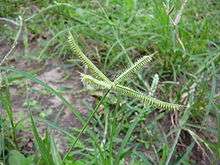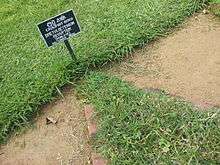Dactyloctenium aegyptium
| Dactyloctenium aegyptium | |
|---|---|
 | |
 | |
| Scientific classification | |
| Kingdom: | Plantae |
| (unranked): | Angiosperms |
| (unranked): | Monocots |
| (unranked): | Commelinids |
| Order: | Poales |
| Family: | Poaceae |
| Subfamily: | Chloridoideae |
| Genus: | Dactyloctenium |
| Species: | D. aegyptium |
| Binomial name | |
| Dactyloctenium aegyptium | |
Dactyloctenium aegyptium, or Egyptian crowfoot grass is a member of the family Poaceae native in Africa. The plant mostly grows in heavy soils at damp sites.
Description

at Peradeniya Royal Botanical Garden
This grass creeps and has a straight shoot which are usually about 30 centimeters tall.[1]
Food
Dactyloctenium aegyptium is still a traditional food plant used as a famine food in Africa, this little-known grain has potential to improve nutrition, boost food security, foster rural development and support sustainable landcare.
Invasive species
In other areas of the world, including parts of the United States, the grass is considered a weed and invasive species.
References
- ↑ National Research Council (1996-02-14). "Wild Grains". Lost Crops of Africa: Volume I: Grains. Lost Crops of Africa. 1. National Academies Press. p. 267. ISBN 978-0-309-04990-0. Retrieved 2008-08-01.
External links
- Jepson Manual Treatment: Dactyloctenium aegyptium
- USDA Plants Profile - Dactyloctenium aegyptium
- Grass Manual Treatment
- Virginia Tech Weed Identification
- Dactyloctenium aegyptium - Photo gallery
- Dressler, S.; Schmidt, M. & Zizka, G. (2014). "Dactyloctenium aegyptium". African plants – a Photo Guide. Frankfurt/Main: Forschungsinstitut Senckenberg.
This article is issued from
Wikipedia.
The text is licensed under Creative Commons - Attribution - Sharealike.
Additional terms may apply for the media files.